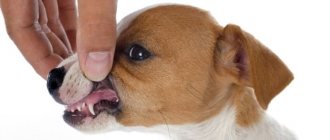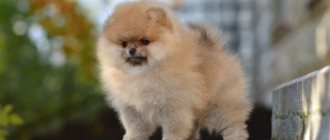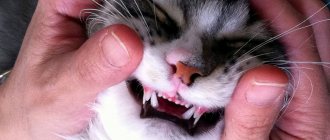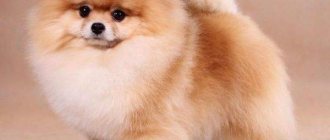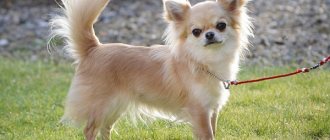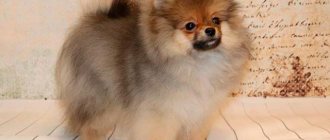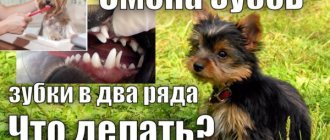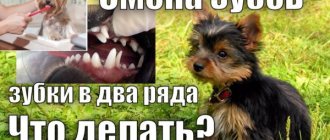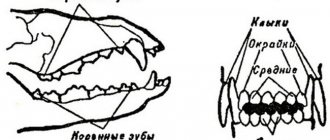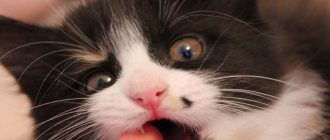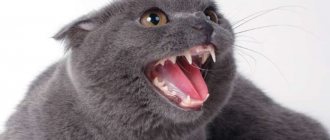Stages of development of the jaw apparatus
The dental system in oranges goes through several stages in development:
- During intrauterine development, dentin formation occurs. In a newborn Pomeranian, bone formations are not yet visible.
- Eruption of temporary or, as they are also called, milk teeth in a kitten. The first baby teeth in Spitz puppies can be seen at about two weeks of age. The anterior units (incisors) emerge, then the cone-shaped primary canines. At the age of 1-1.5, less often 2 months, the entire set is formed in the Spitz. In total, the milk formula includes 28 units: 2 canines, 6 frontal units and the same number of premolars on the upper jaw, which corresponds to the same number of teeth on the lower jaw. When closing the jaws, the upper row should completely cover the lower one. This bite is called a scissor bite and corresponds to the breed standard.
- The appearance of permanent teeth. The process can begin at 5 months and end at 7-8 or even later. By the age of 10 months it should be completed completely. The change of teeth in Spitz puppies is slower and delayed compared to larger breeds.
The rate at which a Spitz puppy's baby teeth are replaced with permanent ones largely depends on the characteristics of their care and nutrition. It is these factors that lead to problems when a Spitz’s teeth change: malocclusion, development of caries, formation of mineralized deposits (stone), delayed eruption, incorrect arrangement.
Contraindications to orthodontic treatment are:
- Age until complete replacement of temporary teeth with permanent ones.
- Metabolic disease.
- Severe somatic diseases.
- Periodontal diseases.
- Aggressive animal temperament.
- Lack of attention and time of pet owners for care and control.
Complications:
- Loss (unsticking) of the bracket.
- Migration of teeth to which the braces are attached.
- Periodontal disease as a result of poor oral hygiene.
- Inflammation in areas where the bracket contacts soft tissue.
- Painful sensations, salivation.
- Migration of corrected teeth back.
In our clinic over the past 2 years, we have tested various types of bite correction techniques: surgical correction - 5 dogs, orthodontic plate and wire cerclage - 11 dogs, dental chain and elastic band - 8 dogs, braces - 24 dogs.
Having analyzed the experience gained, we can conclude that we obtained the best results when using our own developed bracket system technique. It allows you to make a correction without the risk of tooth loss, bring your teeth into alignment and get a stable result. With the surgical method, there is a very high risk of losing a tooth or teeth, the alignment is broken, a very long rehabilitation period and an unstable result. As a result, it should be noted that the orthodontist must be proficient in various techniques, be able to select the most correct technique, and, if necessary, combine them for each pet individually.
Malocclusions in Spitz dogs
Spitz teeth are one of the selection criteria for exhibitions. A representative of the breed cannot be exhibited with the following disqualifying characteristics:
- Overshot – the lower incisors protrude in front of the front ones.
- The frontal units at the top and bottom are in contact with the edges (pincer bite).
- Undershot - gaps when closing the jaw, with the lower cone-shaped units resting on the upper palate.
- Staggered order of cutters due to lack of space.
- Extra front units.
If deviations in the bite are acquired (mainly due to oversight and incorrect actions of the owner), then they can be corrected. For correction, various leash techniques are used. They force the puppy to pull a strap hooked to the lower or upper canines, depending on the problem (underbite or overbite).
For a show career, it is also important how many teeth a dog has. Dogs without one or more front units are not allowed to participate.
Consequences
The chewing apparatus belongs to the gastrointestinal tract and is considered its beginning. Therefore, any deformations of the teeth and jaws negatively affect the digestive processes and have the following manifestations:
- Eating food may be difficult, the dog cannot chew it fully, which provokes gastrointestinal disorders;
- with severe malocclusion, there is a risk of injury to the oral cavity;
- When the jaws are not closed tightly, the dog constantly drools, which causes weeping eczema and other dermatological diseases.
If the animal exhibits small deviations from the norm, and they do not affect the quality of life, then the bite may not be corrected. But usually the decision on the need for correction is made by a veterinarian - an orthodontist.
Problems with teeth, gums, and oral cavity, unfortunately, are not uncommon among cats and dogs. Strong, healthy teeth and oral cavity are a very important part of the animal’s body, affecting the condition of the heart, kidneys, liver and other organ systems. That is why teeth and oral cavity need constant care and timely treatment. Regular and proper care of your pet's teeth and gums will help prevent health problems associated with dental disease.
All our doctors have basic knowledge and skills in dentistry, and also see a specialist dentist by appointment.
The network of veterinary clinics "Vasilek" provides the following types of dental services:
- Examination, consultation and recommendations on hygiene and oral care;
- Comprehensive sanitation of the oral cavity with removal of non-viable teeth, ultrasonic and mechanical cleaning of stone and deposits, grinding of teeth;
- Ultrasonic teeth cleaning;
- Mechanical teeth cleaning;
- Removal of teeth (baby, molars, canines), as well as their roots;
- Treatment of diseases of the oral mucosa: stomatitis, gingivitis, periodontal disease
- Filling, caries treatment;
- Bite correction, orthodontics;.
- For rodents - correction of tooth length, treatment of the consequences of overgrown teeth.
Change of dentition by month
A Spitz's teeth change from 4.5 to 8 months. It is difficult to answer exactly what time the process will begin.
| Eruption time in weeks | ||
| Name | Dairy | Permanent |
| Incisors | 2-3 | 3-5 |
| Fangs | 3-5 | 6-7 |
| Premolars | 4-5 | 6-7 |
| Molars | — | 6-7 |
Permanent units are not erupted all at once, but sequentially:
- The front ones change first - 6 on top and bottom.
The two central incisors are called hooks, on either side of them are the middle incisors, then the edges. The purpose of the frontal units is to bite small pieces of meat from bones and take care of oneself.
At the age of 3-5 months, the Spitz loses the milky anterior units of the lower jaw. The process goes smoothly and easily, since the incisors do not have strong roots.
With the upper ones the situation is more complicated. Often the molars begin to break through even before the baby teeth fall out. The latter fit tightly, which is the reason for the appearance of the second front row. Therefore, in order not to spoil the bite and harm the dog, the temporary incisors are removed.
- At about six months, Spitzes change their cone-shaped units.
Their purpose is to defend/attack and tear large pieces of meat. In almost 99% of cases, the fangs are pulled out by a veterinarian. If they are well loosened, then without anesthesia, if not, removal is carried out under general anesthesia.
You cannot leave the fangs, because they will cause an incorrect bite and may deform the jaw. If the permanent cone-shaped units grow along with the milk ones, you should not expect the situation to be resolved. When the upper canines grow to the size of milk teeth, they are removed. The lower ones are pulled when they reach the middle of the dairy ones.
- The last to erupt are the premolars and molars.
Premolars (8 above and the same number below) and molars (5 on each jaw) do not have deciduous predecessors. They appear during the period of milk cycle change every six months. With their help, the dog chews and grinds food.
According to the standard, Spitz dogs have 42 permanent units. (more on the lower jaw – 22, on the upper – 20).
| Incisors | Fangs | Premolars | Molars | Total |
| 12 | 4 | 16 | 10 | 42 |
A set of teeth necessarily includes 6 anterior units below and above. However, the Spitz breed standard allows for the absence of several premolars.
All teeth should be white, without yellowness, enamel wear or wear.
Dental injuries
Both adult dogs and puppies can injure their teeth. Usually, dislocations and fractures of teeth occur due to playing with sticks, bones, too dense toys, or horns. Access to all dangerous objects must be prohibited.
Features of tooth loss in dogs of large and small breeds
Teeth loss, as well as tooth loss, begins earlier in miniature breed dogs. However, there can be exceptions to any rule. Genetic factors, hygiene, and oral diseases can influence tooth loss.
Medium and large breeds
With good oral care, teeth in large and medium-sized dogs begin to fall out due to age-related changes around the age of 10 years. First, your pet will begin to lose the lower incisors due to increased stress on them and a weak root. The remaining teeth are held more firmly in the jaw, so the dog may lose them due to periodontitis. In a healthy oral cavity, teeth can wear down with age and can be preserved into old age with proper care.
Causes of deviations from the norm in Pomeranians
The problem with Spitz dogs is the delayed replacement of incisors and canines. The animal's milk units have long roots, so they are difficult to fall out and interfere with the proper development of the roots. Often in Spitz, the molar cone-shaped units grow adjacent to the temporary ones, which affects the direction of growth of the entire dentition.
Change-related problems arise for the following reasons:
- The rudiment of the permanent incisor is located incorrectly and therefore it can grow in any direction.
- Weak chewing muscles. In this case, the jaw does not compress tightly and the pressure on the primary incisors is small. Accordingly, they become looser less. Therefore, it takes longer for a tooth to fall out.
- The Spitz has a narrow jaw. When the molars begin to grow, but the deciduous ones are still holding on, there is not enough space for everyone. So, very often they move back or forward from their normal position.
- Lack of calcium in the puppy’s diet or its poor absorption.
- Feeding with soft food.
- A short time allotted for eating. The jaw does not receive the proper load.
Pomeranians have a breed predisposition to abnormal development of the dental system. Therefore, problems with changing teeth in Pomeranians occur quite often.
How to solve a problem
Acquired malocclusions can be corrected. This is not a task for one week or even a year, but the efforts will be generously rewarded. Upon completion of treatment, the dog will be able to take part in exhibitions and will be allowed to breed.
But even if the owner does not have the goal of pursuing a show career, it is necessary to treat his pet’s pathological bite. This is the key to his health and full life. It is better to do this when the puppy is not yet a year old.
Let's look at how to correct a dog's bite. This can be done in several ways, namely:
- removable devices;
- non-removable structures.
Removable devices
These include the so-called transparent removable aligners. They are placed over the teeth and should be worn at all times except when eating and brushing teeth. Their effect is constant and fairly strong pressure on the teeth in the desired direction. Every few months the design is replaced with a new one. It exerts stronger pressure, under the influence of which the teeth take the right direction. The orthodontic veterinarian must monitor the treatment process.
Removable braces can be used for puppies. They are shaped like a hard rubber ring. The principle of their action is the same, but they exert gentler pressure on the teeth.
Fixed structures
These are permanent braces. They are made of dense material and are firmly attached to the teeth using special dental glue. The force of their pressure is regulated using a special wire that connects the clasps that are put on the teeth. If necessary, the wire can be changed, thereby increasing or decreasing the pressure force.
Fixed structures have their contraindications. They cannot be installed if you have periodontal disease, stomatitis, or an allergic reaction to the braces material. Treatment is usually long-term.
Help at home
Each dog has its own development speed, so there is no need to rush the change of canines and incisors. During this period, the main thing is to do no harm:
- Do not entertain your pet with tug-of-war games or let him hang on various objects. The jaw is easily deformed, which leads to malocclusion.
- To loosen the milk units, you can give toys-bones made of leather or sinew, unsweetened crackers or whole carrots.
- Pomeranians need to eat properly. With a natural diet, mineral supplements with calcium and vitamins are required. Dairy products are included in the diet as a source of calcium.
From childhood, a puppy must be taught oral hygiene to prevent the formation of plaque, which can cause tooth loss and gum disease.
Fixes
Unfortunately, in most cases, it is quite rare to achieve a normal bite in a dog with incorrect position of the jaws or teeth. But of course, its owners can try to help such a pet.
There are only two ways to correct a bite in dogs:
- surgical;
- orthodontic.
Veterinarians use the first technique to correct the position of animals’ jaws. The second technology is used for dog teeth.
When is dental care needed?
If your Spitz's teeth change is not going according to schedule, there are fewer teeth than needed, or there are deviations in the bite, you will need the help of a dentist.
Normally, the process goes according to the following scheme:
- The rudiment of permanent bone formation is formed under the milky root and begins to grow.
- The temporary root becomes mobile and falls out over time.
- The permanent incisors/fangs grow in the same canal where the milk teeth were and take their place.
Situations are possible when the primary anterior units and canines have not yet fallen out, but a number of permanent ones have begun to grow.
The dog has 2 rows on one jaw, as can be seen in the photo. There are cases when there are up to 60 teeth in the mouth, and they are shifted in different directions. The Spitz begins to experience discomfort.
Incorrectly growing fangs are especially inconvenient. They injure the tongue, lips, and palate. Ulcers and bleeding appear. It becomes painful for the dog to eat. And the owner can try to pull out the loose fangs himself. If this does not work, contact the veterinarian.
Important:
- You can delete a temporary unit if a root unit has already appeared next to it. Otherwise, the rudiment may be damaged, and the fang or incisor will not grow at all.
- The entire milk supply must be disposed of before 9 months. If removed later, it will not be possible to restore the bite.
Another pathology is incomplete dentition. In this case, the dog is missing some of the units. An x-ray is taken to determine whether there are rudiments in the jaw. If they are present, an incision is made in the gum to facilitate eruption. The dog is put into medical sleep and anesthesia is applied.
Using braces
Such orthodontic devices are used to correct bites in dogs quite often. The operating principle of this type of structure is extremely simple. Braces press the dog's teeth into the correct position. The animal usually does not experience any particular discomfort. Under the pressure of braces, the dog's teeth gradually begin to shift. In this case, the free space formed in the same place is filled with bone tissue.
In some cases, wearing braces for dogs may, of course, be contraindicated. Do not correct an animal’s bite in this way, for example, if they have problems such as:
- allergy;
- ulcerative stomatitis;
- gingivitis;
- formations in the oral cavity.
Dogs wearing braces must also have their teeth brushed. Therefore, pet owners who decide to correct their bite using such a design should begin to accustom them to such a procedure in advance.
Care
During the period of teeth change, the puppy needs special care and attention. At least 2 - 3 times a week you need to examine the mouth of a small Yorkie and, if it turns out that the growth of the molars is hampered due to the milk teeth that have not yet fallen out, it is necessary to take measures to remove them. When playing with a puppy, you should not pull anything from his mouth: this can easily ruin his bite. It is also undesirable to let your puppy chew on hard objects, as it can damage or even break the tooth.
In order for a Yorkie to develop its jaw muscles, it is necessary to give it not soaked dry food, but solid food with anatomically shaped granules that clean the surface of the tooth and at the same time contribute to the proper development of the dog’s jaws. At the same time, during the change of teeth, it is better to feed the puppy food with a high content of calcium and phosphorus.
If your pet eats natural food, then it is necessary to add vitamin and mineral supplements to its food. If this is not done, then problems may begin not only with the correct growth of teeth, but also with the exterior in general. For example, ears may fall off and paws may become crooked. It is very useful for growing puppies, and even adult Yorkies, to chew on special toys, as well as peeled raw carrots or an apple.
If plaque does form on the teeth, it can be cleaned off using a toothbrush with a special dog paste applied to it. Human pastes and tooth powders cannot be used for these purposes: they can cause allergies or stomach problems.
In order to reduce the risk of problems with teeth and bite, you should not take puppies whose estimated weight is less than 2 kg.
And if the owner is interested in the exhibition or breeding career of his pet, then it is better for him to buy a dog after changing teeth. If you take a small puppy, then you need to see what kind of bite his parents have.
